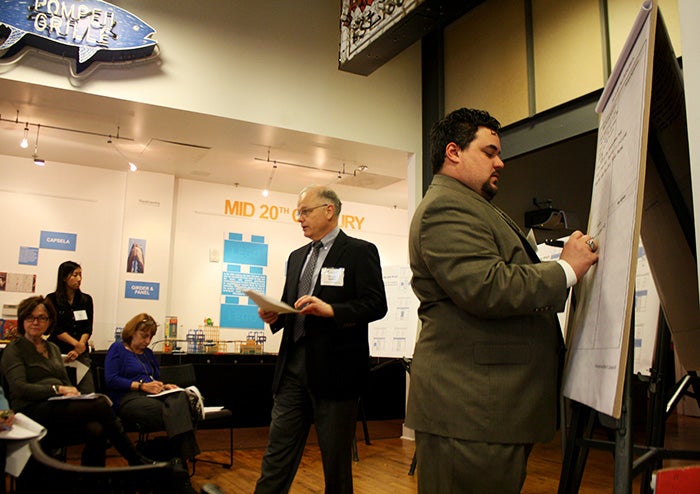Civic engagement on sign controls gets underway

The inter-agency working group responsible for reforming Philadelphia’s sign regulations held the first in a series of five “facilitated discussions” with stakeholder groups Thursday morning at the Center for Architecture. The working group, represented by former Zoning Code Commission staff members Eva Gladstein and Natalie Shieh, sought input on sign control reform from architects and design professionals associated with the Design Advocacy Group (DAG).
The discussion was held at the request of the Philadelphia City Planning Commission during a regularly scheduled DAG meeting.
Eva Gladstein began the discussion with a short presentation, providing background on the work of the ZCC, which had elected to pass the bulk of a new zoning code last December, and to reform sign controls separately. The current sign regulations are seen as an especially outdated and confusing portion of the zoning code. Gladstein, now deputy director of the Planning Commission, said the working group intends to send a reformed, consolidated chapter on sign controls to City Council this May.
Last week, Gladstein and her group released a survey on zoningmatters.org intended to gauge visual preferences for signs. The new zoning code is scheduled to go into effect on August 22nd of this year.
Gladstein first reviewed information the group previously made available in two information sheets posted on the zoning website. The sheets assess the problems with the current regulations and recommend definitions for reformed sign types and characteristics. This information was the subject of previous PlanPhilly coverage.
After explaining the proposed classifications for accessory signs, Gladstein told DAG members that the working group was looking into creating incentives for the removal of existing non-accessory signs—billboards—in certain areas of the city. After the meeting, Gladstein told PlanPhilly that the incentive plan is “very theoretical at this time,” but could involve changing the billboard replacement ratio—currently 1 to 1—to reduce sign density in certain areas of the city.
Gladstein and Natalie Shieh split the DAG members into two groups to discuss specific proposals and measure attitudes toward sign regulations in Philadelphia. Officially, all DAG meetings—as well as the remainder of the sign control group’s facilitated discussions—are off the record. Generally speaking, though, the discussion raised a number of important questions for the working group to address as it drafts a new chapter on sign controls.
Among them:
- Should accessory roof signs be considered separately from the buildings they top, or should they add to the total building height?
- Should the zoning code regulate the quantity of signs in a given area in addition to the type, size and characteristics?
- Should certain types of sign materials (wood, cardboard, plastic, and so on) be regulated separately?
- Should the zoning code regulate the length and/or sound of animated messages on digital signs?
- What type of presence should signs have in neighborhoods dominated by twin and single-family homes?
- What is the proper way to balance the commercial necessity of signs with the aesthetic desirability of sign moderation?
In one exercise, Gladstein and Shieh, assisted by representatives from Portfolio Associates, Inc., showed DAG members illustrated models of storefronts adorned with different proportions of signage, from 2 sq. ft. of sign area per linear foot of storefront up to 4, 6, and 8 sq. ft. per linear foot of storefront. DAG members were asked to voice the most preferable and least preferable of these choices.
At least one of the two groups was unanimous in placing 8 sq. ft. of signs per linear foot of storefront—the most sign-crowded of the options—in the “least preferable” category. But “most preferable” votes were cast for each of the other three options.
After the meeting, Joanne Aitken, chair of the Design Advocacy Group, said the discussion had “produced a lot of information” for the design professionals in attendance, and she was happy that DAG was engaged by the working group.
But Aitken also said that the sign control reform process could benefit from taking a step back. She feels that the reform is too focused on the details of the types of sign controls that are currently in place, and that it should instead proceed from a coherent vision.
Aitken said the sign regulations should be responsive to a fundamental question: “What is it we want in terms of the look of our city?”
In response to that suggestion, Gladstein said she plans to add more context to her next presentation about the overarching purposes of sign regulations. She said that each stakeholder group’s suggestions are bound to be “widely disparate,” but that the group would do its best to respond to the legitimate concerns of everyone who gives input.
“We try to learn from what we’re doing and we try to make adjustments,” Gladstein said.
She added that, ultimately, each stakeholder group recognizes that it will benefit from reformed sign controls.
“For whatever reason,” Gladstein said, “[sign] amendments [in the current code] were done in a manner that was less consistent even than the rest of the amendments.”
The sign control working group—which includes representatives from Philadelphia’s Commerce, Law and Streets departments, L&I, the Art, Historical, and Planning commissions, and a handful of former Zoning Code Commissioners—will hold four more stakeholder meetings this month, with small business owners, civic associations, CDCs, and one open meeting. It plans to present a draft of a new sign control chapter at a Planning Commission meeting February 21st, before holding five more neighborhood-based civic engagement meetings.
“Kudos should be given to [Gladstein] and the whole process,” said Joanne Aitken, “in how open and transparent it has tried to be.”
Contact the reporter at jaredbrey@gmail.com
WHYY is your source for fact-based, in-depth journalism and information. As a nonprofit organization, we rely on financial support from readers like you. Please give today.






